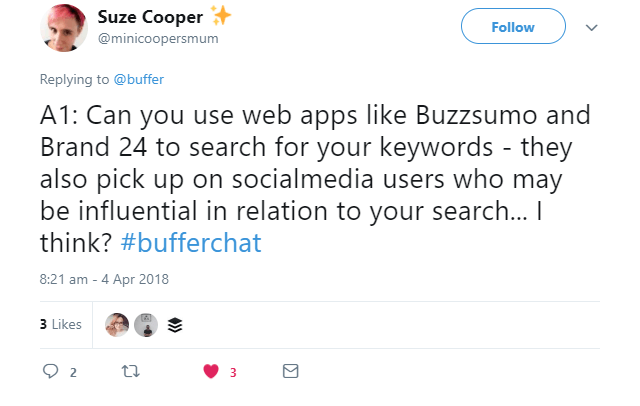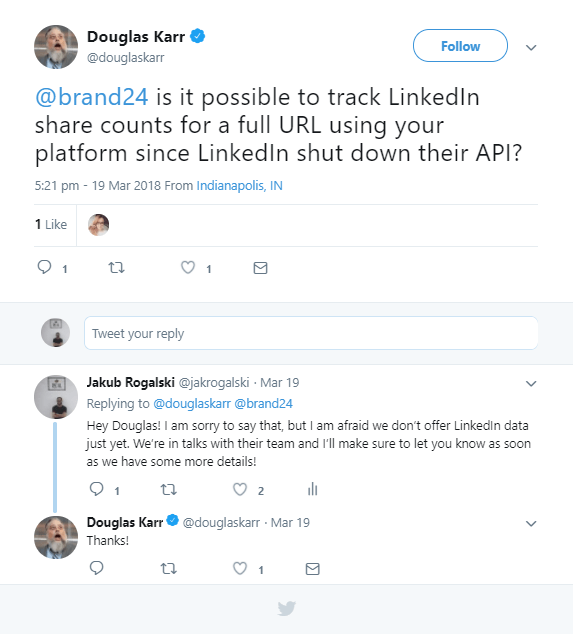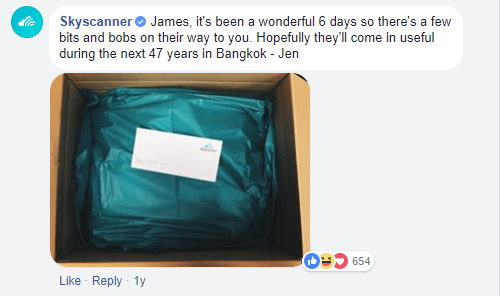Why Your Brand Is Lost Without Social Media Customer Service
32% of users who contact a brand expect a social media customer service response within 30 minutes, and 42% expect a reply within 60 minutes.
These are not just some numbers out of the blue, but a result of research by Convince&Convert in which 690 persons from a sample of over 3,000 American social media users who have reached out to a company for support via social.
The stats get even more interesting when you realise 57 per cent expect the same response time at night and on the weekends. Sounds crazy, right?
But then, when you think how much social media has revolutionized customer service, it becomes more and more understandable. In the pre-social media days you’d probably contact different customer service departments via e-mail, phone calls, or simply face to face conversations in the shops you purchased your items from.
We can’t deny it’s quite different these days. Whenever you want to get in touch with the business you purchased a product or service from, you’ll most likely reach out to them via social media, whether it’s Facebook, Twitter, Instagram, or any other social network. That’s because we assume they are online at all times and it seems obvious to us right away. However, that’s not always the case.
I’d rather not call out names of different brands, but I’ve seen instances when some of the customer service requests were ignored for days. I cannot stress enough how much of a bad practice it is, and I have some more stats to back it up.
Conversocial in their report, The Definitive Guide to Social, Mobile Customer Service claim 88 per cent of consumers are less likely to purchase from a company that leaves questions on social media unanswered. That should teach a lesson to those companies neglecting their social media customer service responsibilities, especially when we take into account how influential social networks are in the decision-making process.
On the other hand, I am pretty sure I know what could be one of the reasons why some brands don’t engage the people looking for social media customer service. Another report from Conversocial I had a look at claims that only 3% percent of tweets tagged the brand that a customer was looking for help from. This means that a whopping 97% of users mentioned the brands without using their twitter handle. That’s the research based on the analysis of 11,723 Tweets on Costco, Kroger, Safeway, and Walgreens over a 24-hour-period.
Still, we shouldn’t blame the consumers for not using Twitter handles of the brands they are reaching out to, but rather the brands for not paying enough attention to their customers and potential customers.
That’s where some of the best social media customer service practices come into play.
Media monitoring is the first on the list. As long as you set up your monitoring project correctly, you should be able to collect all mentions of your brand or product, both tagged and untagged, alongside some common misspellings and variations of your names that people could come up with.
When I look into the settings of my project for mentions of Brand24, not only do I monitor “@brand24”, “Brand24”, but also “Brand 24” so I won’t let any mentions slip through. Here’s the freshest example:
It’s not like Suze is looking for help from us, but it’s still vital to engage such mentions. I would have probably missed it if it wasn’t for monitoring different variations of “Brand24” keyword. Can you imagine browsing different social networks one by one in search of such mentions? Sounds tiresome and that’s why it’s most productive to use a media monitoring tool out of all those available on the market.
You’ll also need to adapt to the tone of voice of your customers. If a customer seems to be mad about something that happened to him or her, tread lightly and try to avoid solving his problems in a humorous way. They might feel you’re not taking their concerns seriously and this will make matters even worse.
Oftentimes, the reason for their pains might be their mistakes rather than yours. Even in such situations, it’s a good idea to acknowledge what they are going through because of the problems they’re having and let them know you’re sorry they’ve found themselves in a problematic position.
On top of that, we strongly believe that honesty is the best policy. Don’t try to overpromise something you know you won’t be able to deliver.
If you don’t know how long it’s going to take you to fix something for your customers, let them know you’ll get in touch with someone more knowledgeable in a given topic and that you’ll get back to them as soon as you have some more details. Even if you know you won’t be able to solve a customer’s problem on the spot, it’s better to let him know you acknowledged what’s going on rather than ignoring their questions until you’ve found the perfect solution.
Another thing you might have noticed on the image above is the use of a personal profile instead of a company profile. We try to do this as much as possible as it makes contact with a brand more personal. You can either do this or include your names or initials at the end of your replies. Still, we prefer using our personal profiles as it’s easier to build relationships this way rather than with your company profile.
You should also have a pretty good understanding of when someone is genuinely having a problem and when it’s just a troll fooling around. If you feel that it’s the latter, it’s usually a good idea not to get involved in such conversations.
Now, on another note, let’s talk about the lighthearted tone of voice of your customers. You’ll probably be able to figure this out by the use of emojis or some other media like images or gifs included with the posts.
Ever heard of Skyscanner and the 47-year layover their website suggested?
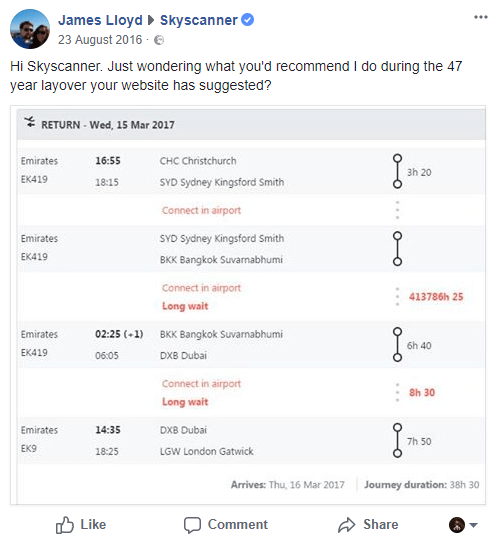
It could’ve been just a regular, maybe even boring social media conversation saying something along the lines of “Hey James, we’re sorry for the miscalculation, please refresh the website for the correct information!”.
Luckily, it ended up as one of the most hilarious Facebook exchanges I’ve ever come across.

Ladies and gentlemen, meet Jen! Have a look at the number of reactions it has received over a year!
Judging by the comments, people were totally amused with social media customer service from Jen, and it didn’t end there with her popping into the conversation every now…
…and then…

That last bit was published a year after the initial reply from Jen. It could’ve easily been forgotten by that time, but Skyscanner took the opportunity to remind their fans of what could be their most impressive social media conversation ever. How cool is that?!
This one is old but gold. Fishy Sainsbury’s, the wet dream of all pun enthusiasts. It takes an insane level of creativity and language skills to pull something like this off, and I am pretty most of us wouldn’t even come close to this. I’d still love you to take a look at this masterpiece of a social media customer service!
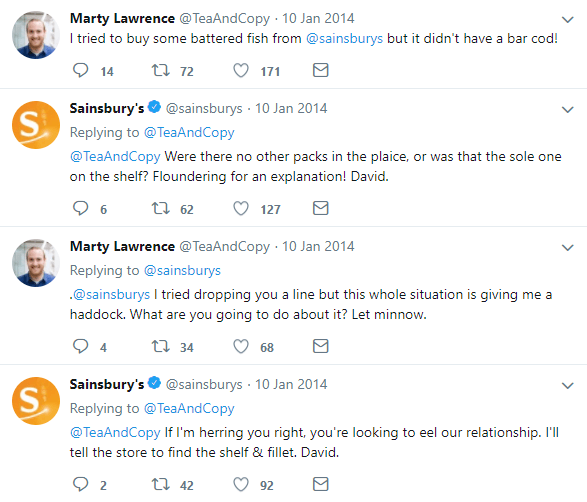
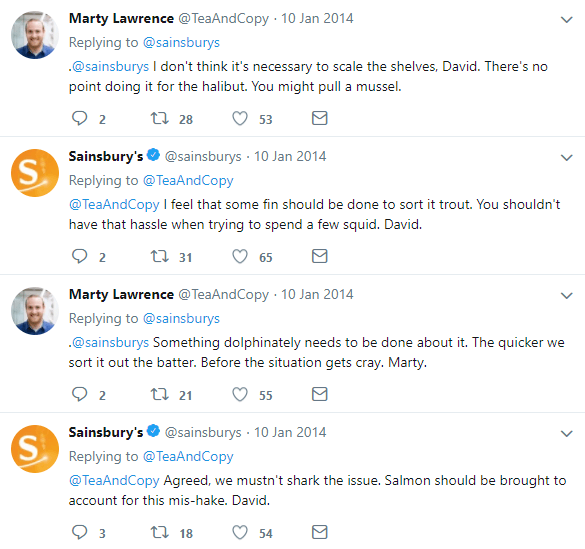
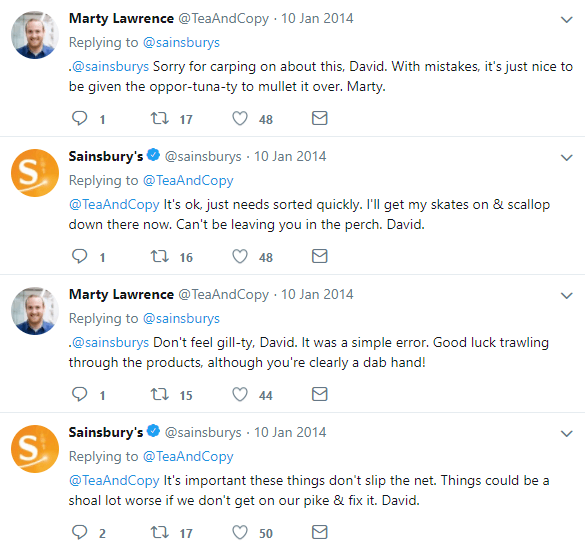
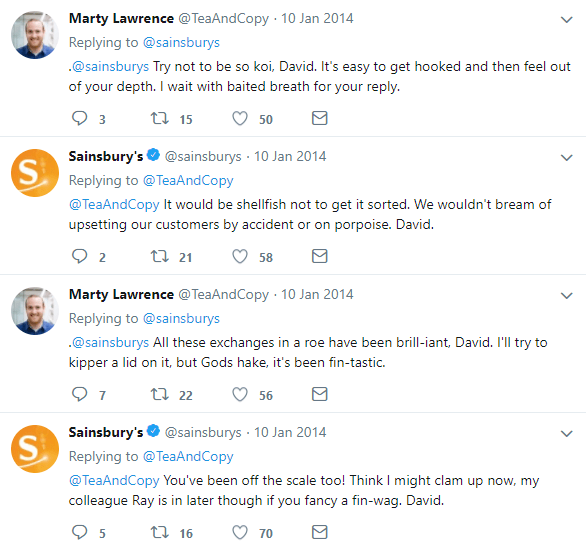

As you can see, there are different ways to delight your customers. The way you communicate with them very much depends on their tone that they set by starting the conversation.
Some more stats to wrap social media customer service up
It’s no wonder customer satisfaction rises when a brand responds to people on social media. A consumer survey conducted for Sprout Social indicates that when this happens:
- 70% of people are more likely to use a brand’s product or service.
- 65% of people have more brand loyalty.
- 25% of people are less likely to go to a competitor.
- 25% of people are less likely to post negative things about the brand, product or service.
- 75% of people are likely to share a good experience on their own profile.
Those stats should be shown to any business that is not taking care of their social media customer service. Ignoring consumers will eventually affect the bottom line of such businesses, and that’s something none of the business owners wants.
Related articles
Top Reads
Brand Monitoring: Tools & Guide for 2026
Brand Awareness Strategy [The Ultimate Guide for 2026]
The Best AI Hashtag Tracker and Other Hashtag Tracking Tools [2026]
Social Media Reach: How to Measure & Improve It in 2026?
X (Twitter) Analytics Tools: The 10 Best to Try in 2026
Sentiment Analysis: What is it & Why do You Need it in 2026?
Share of Voice: Definition, Calculation, Tools [2026 Guide]
Brand Reputation Management: 6 Expert Tips for 2026
A Complete Guide to AI Social Media Analysis [2025]
How to See How Many Times a Hashtag Was Used on X (Twitter)
Start Social Listening!
Get the Brand24 trial and start social listening like a PRO.
